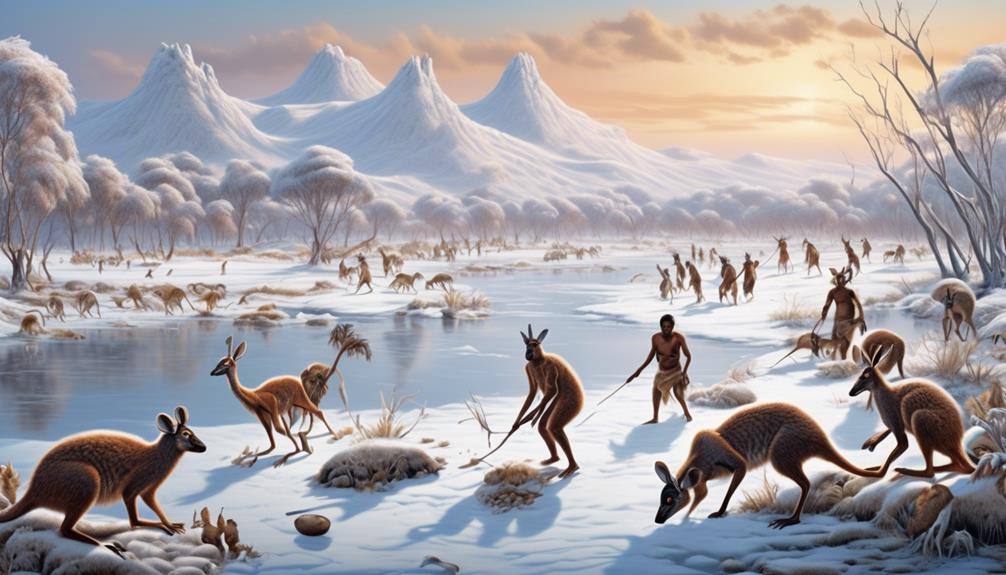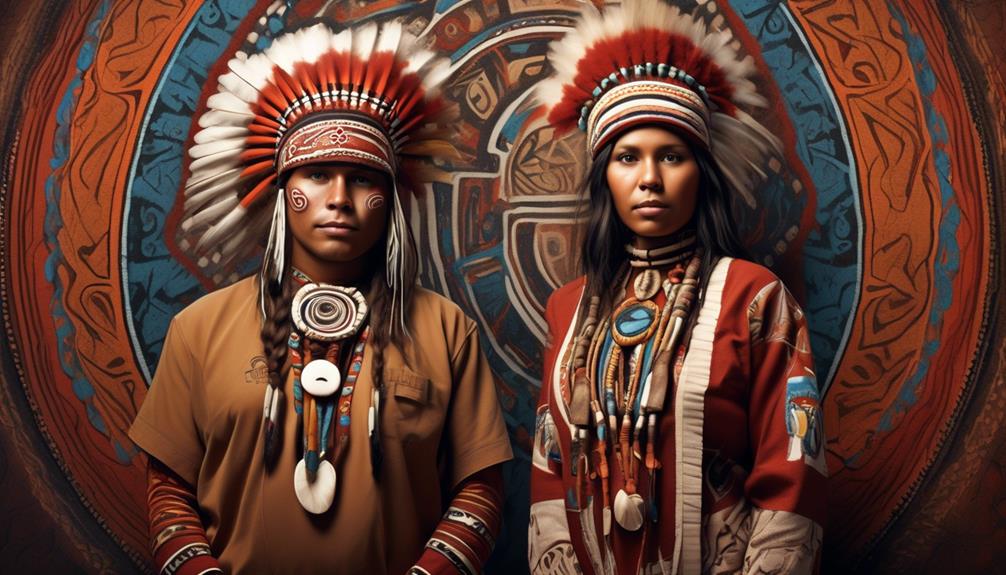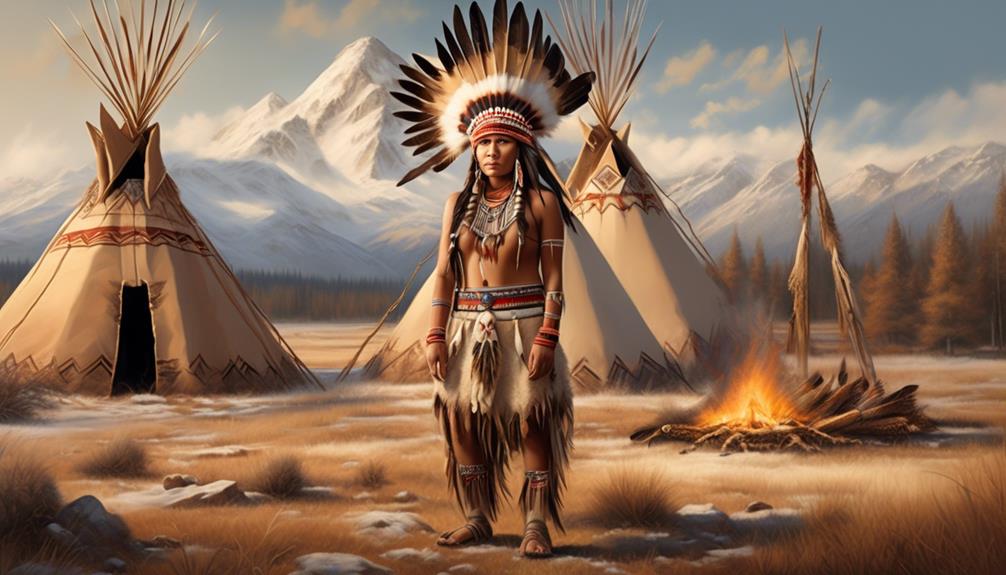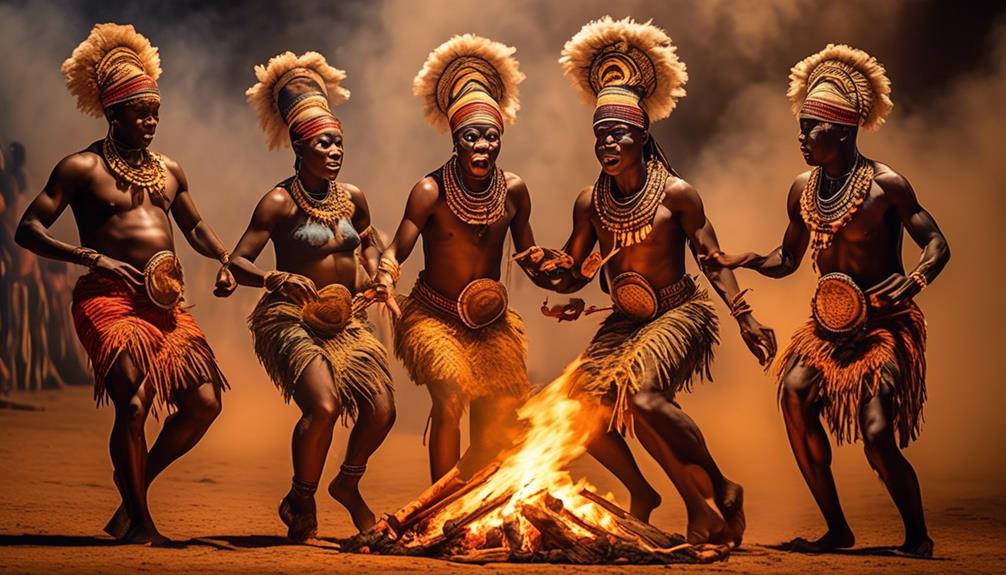Have you ever considered the possible arrival of Aboriginal Australians on the continent, a concept similar to the Bering Land Bridge theory?
The journey of the first human inhabitants of Australia is a fascinating puzzle that has captivated researchers for decades. Through a combination of archaeological evidence, genetic studies, and ancient oral traditions, we are beginning to uncover the remarkable story of how these early humans arrived in Australia.
But what exactly do these different sources of evidence reveal about this ancient migration?
Key Takeaways
- Migration out of Africa occurred approximately 60,000 years ago, as early humans ventured into new territories in search of resources and suitable habitats.
- Ancient humans migrated from Africa to Eurasia via land bridges during periods of low sea levels, driven by the search for food, favorable climates, and territorial expansion.
- Genetic analyses reveal that Aboriginal Australians are descendants of one of the oldest continuous cultures in the world, with roots tracing back over 50,000 years.
- Aboriginal Australians transmit knowledge, history, and cultural practices through oral traditions and Dreamtime stories, which hold spiritual significance and foster a sense of identity.
Early Human Migration Out of Africa
The migration of early humans out of Africa is a pivotal event in the history of human civilization, shaping the cultural and genetic diversity of populations around the world. It's believed that early humans began their journey out of Africa approximately 60,000 years ago, venturing into new territories in search of resources and suitable habitats. This migration was driven by various factors, including the development of Paleolithic tools, which enabled early humans to adapt to diverse environments and thrive in new lands. Climate change also played a significant role in this migration, as shifts in environmental conditions prompted human populations to seek more hospitable regions.
The dispersion of early humans from Africa marked the beginning of a remarkable journey that ultimately led to the peopling of diverse regions across the globe. As these early human groups migrated, they encountered and adapted to a wide range of environments, contributing to the rich tapestry of human cultural and genetic diversity that we observe today. Understanding the mechanisms and drivers of this ancient migration provides valuable insights into the history and development of human societies, shedding light on the remarkable resilience and adaptability of our ancestors.
Land Bridges and Sea Crossings
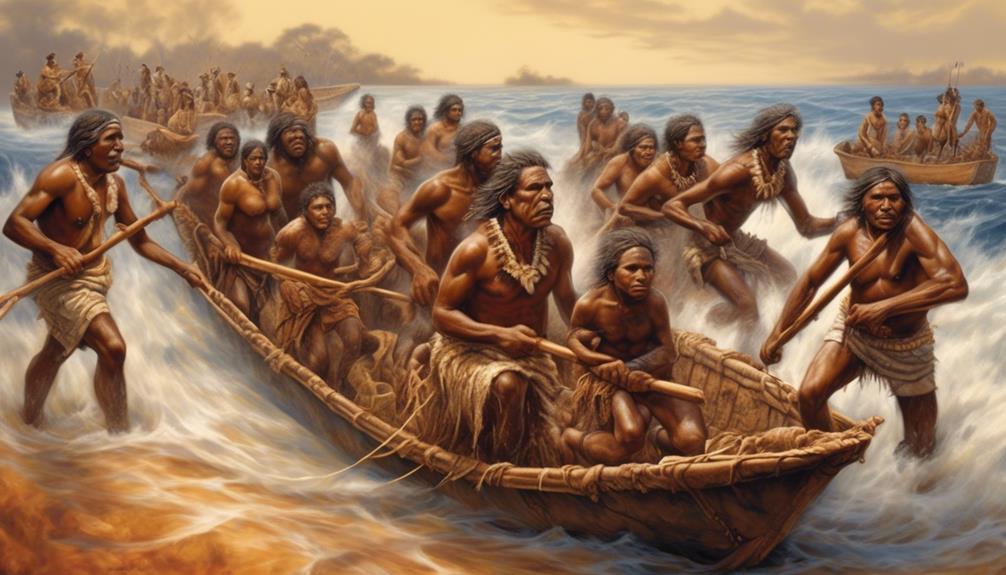
Venturing across land bridges and navigating treacherous sea crossings, early human populations embarked on a remarkable journey out of Africa, seeking new horizons and opportunities for survival.
The land bridge theory suggests that ancient humans migrated from Africa to Eurasia via land bridges that emerged during periods of low sea levels, allowing them to cross into new territories. This migration was likely driven by the search for food, favorable climates, and the expansion of territories.
As sea levels fluctuated, coastal migration routes became crucial in shaping the dispersal of early human populations. The coastal migration route is believed to have played a significant role in the peopling of Australia, as it provided access to the continent's northern regions. These early seafarers navigated through challenging waters, showcasing their remarkable maritime skills and resilience.
The successful navigation of sea crossings was pivotal in reaching Australia, marking a significant milestone in human migration history. Understanding these remarkable feats of ancient seafaring not only sheds light on the incredible resilience of early human populations but also enriches our appreciation of the diverse cultural heritage of Aboriginal Australians.
Genetic Evidence of Ancestral Lineage
Embarking on a scientific exploration, we delve into the genetic evidence that illuminates the ancestral lineage of Aboriginal Australians. Through the study of ancestral DNA, researchers have uncovered crucial insights into the migration patterns of the first peoples of Australia. Genetic analyses have revealed that Aboriginal Australians are the descendants of one of the oldest continuous cultures in the world, with roots tracing back over 50,000 years. These findings not only provide a scientific understanding of the ancient lineage but also hold immense cultural and historical significance for Aboriginal communities.
The genetic evidence points to a remarkable journey of migration, showing that Aboriginal Australians have a deep connection to the land and have maintained a strong cultural identity through millennia. By tracing the migration patterns through ancestral DNA, scientists have been able to map the dispersal of early populations across the Australian continent, shedding light on the diverse and complex history of the first Australians.
This knowledge not only enriches our understanding of human history but also honors the enduring legacy of the Aboriginal peoples.
Oral Traditions and Dreamtime Stories
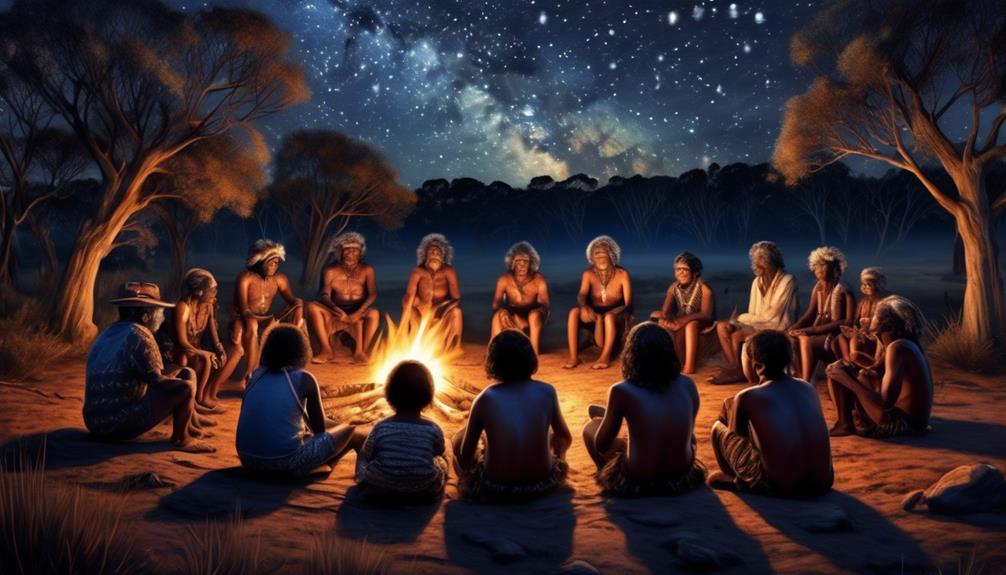
How do Aboriginal Australians pass down their cultural heritage through oral traditions and Dreamtime stories?
Cultural significance and storytelling play a crucial role in the transmission of knowledge and values from one generation to the next. Indigenous perspectives and spiritual beliefs are intricately woven into these narratives, providing a holistic understanding of the world and humanity's place within it.
- Oral Tradition: Aboriginal Australians have maintained a rich tradition of orally transmitting knowledge, history, and cultural practices through storytelling. These stories are often passed down through generations, preserving the wisdom and experiences of their ancestors.
- Dreamtime Stories: The Dreamtime, also known as the Dreaming, is a fundamental aspect of Aboriginal culture, encompassing a vast body of knowledge about creation, spirituality, and natural laws. Dreamtime stories are a means through which the Aboriginal people connect with their ancestral lands and understand their place in the cosmos.
- Spiritual Significance: These stories aren't merely folklore; they're deeply intertwined with spiritual beliefs, providing a framework for understanding the world and forming the basis of Aboriginal spirituality and connection to the land.
Through oral traditions and Dreamtime stories, Aboriginal Australians continue to uphold their cultural heritage, fostering a deep sense of identity and belonging within their communities.
Arrival and Settlement in Australia
Continuing from our exploration of oral traditions and Dreamtime stories, the arrival and settlement of Aboriginal Australians in Australia marks a pivotal moment in their rich cultural history. The Aboriginal culture is deeply rooted in a profound connection to the land, and this is evident in their environmental adaptation upon arrival in Australia.
As the first inhabitants of the continent, Aboriginal Australians displayed remarkable resilience and ingenuity in adapting to diverse landscapes, from lush rainforests to arid deserts. Their deep understanding of the environment enabled them to thrive for thousands of years, developing sophisticated hunting and gathering techniques, sustainable land management practices, and intricate social structures.
The arrival and settlement of Aboriginal Australians in Australia also laid the foundation for the diverse cultural tapestry that exists today. Through their deep spiritual connection to the land, they established a profound sense of belonging and stewardship, shaping their identity and traditions.
It's through their enduring connection to the land and the wisdom passed down through generations that we continue to learn valuable lessons about sustainability, community, and respect for the environment.
Frequently Asked Questions
What Impact Did Early Human Migration Out of Africa Have on Other Parts of the World?
Early human migration out of Africa had a significant impact on other parts of the world. It led to cultural exchange, adaptation to new environments, and environmental changes.
As humans spread to different regions, they encountered new climates, landscapes, and resources, which influenced their ways of life. This migration fostered the development of diverse cultures and societies, contributing to the rich tapestry of human history and civilization.
How Did the Concept of Land Bridges and Sea Crossings Contribute to the Migration of Aboriginal Australians to Australia?
Land migration and coastal navigation were crucial for the migration of Aboriginal Australians to Australia. The concept of land bridges and sea crossings played a significant role in their journey.
This migration had a profound impact on the cultural and historical development of Australia. The scientific evidence supports the idea that these early migrations shaped the landscape and contributed to the diverse cultural heritage of the Aboriginal Australians.
What Specific Genetic Evidence Supports the Ancestral Lineage of Aboriginal Australians?
Genetic evidence, such as mitochondrial DNA analysis, supports the ancestral lineage of Aboriginal Australians. This evidence reveals a deep-rooted connection to the land and traces migration patterns of the first human settlement.
These genetic studies provide insights into the historical movements of populations and the impact of migration on shaping the genetic diversity of Aboriginal Australians over time.
The research sheds light on the intricate and enduring ties between genetics, culture, and human history.
Can You Provide Examples of Oral Traditions and Dreamtime Stories That Have Been Passed Down Through Generations?
Sure!
Examples of oral traditions and dreamtime stories have been passed down through generations in Aboriginal Australian culture. These stories reflect the deep connection to the land and the spiritual beliefs of the indigenous people.
Generational storytelling has preserved rich cultural heritage, providing insights into migration impacts, settlement challenges, and ancient history.
These traditions, supported by genetic evidence, offer valuable contributions to understanding the origins and resilience of Aboriginal Australians.
What Were the Challenges Faced by Early Aboriginal Australians Upon Their Arrival and Settlement in Australia?
Upon arrival, early Aboriginal Australians faced numerous challenges. Settlement struggles included adapting to new environments, finding food sources, and establishing social structures.
The harsh Australian landscape presented obstacles such as extreme weather, unfamiliar flora and fauna, and limited resources. Despite these adversities, our ancestors exhibited remarkable resilience, utilizing their deep knowledge of the land and developing intricate cultural practices to navigate and thrive in this new territory.
Conclusion
In conclusion, the journey of the Aboriginal Australians to Australia is a remarkable testament to the resilience and adaptability of the human species. As genetic evidence and oral traditions continue to shed light on their ancestral lineage and migration patterns, we gain a deeper understanding of their rich cultural heritage.
For example, the oral traditions of the Yolngu people of Arnhem Land in northern Australia provide valuable insights into their ancient migration and settlement in the region.
Mary is a passionate writer who brings creativity and a fresh perspective to our team. Her words have the power to captivate and inspire, making her an essential contributor to our content. Mary’s commitment to storytelling and dedication to promoting Indigenous culture ensures that her work touches the hearts of our readers. We’re fortunate to have her as part of our team.

